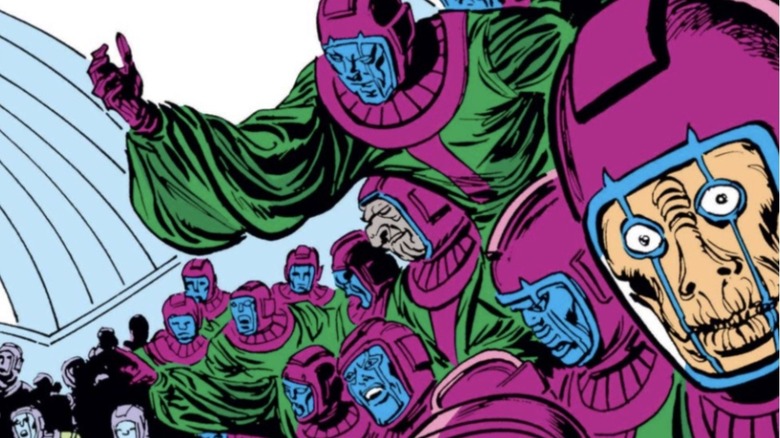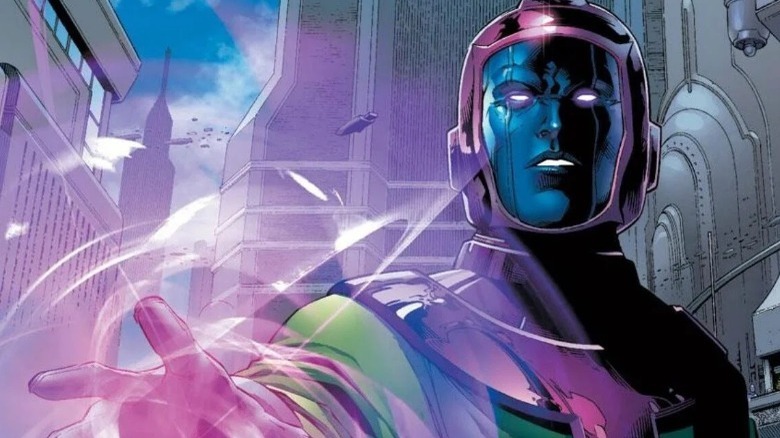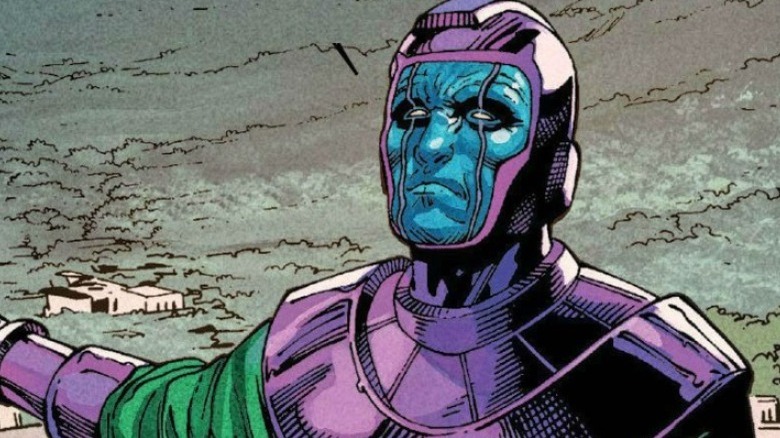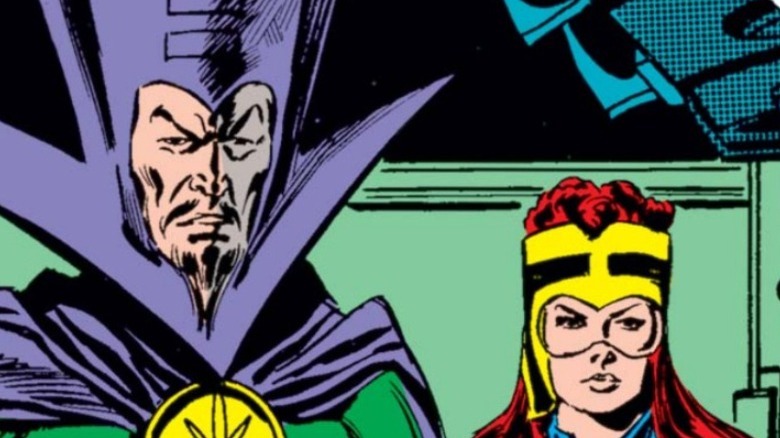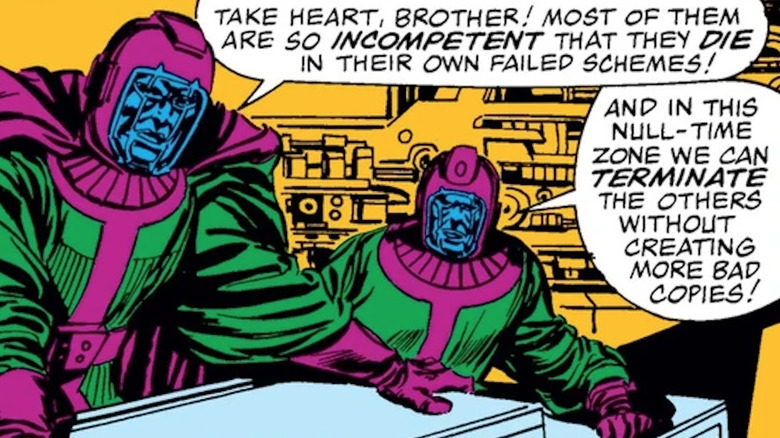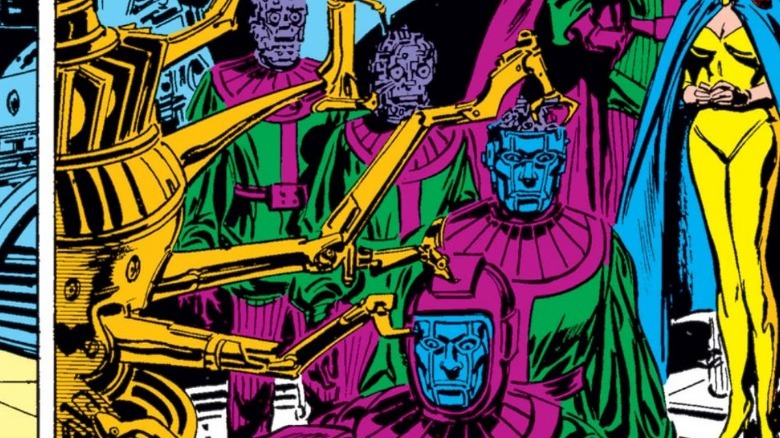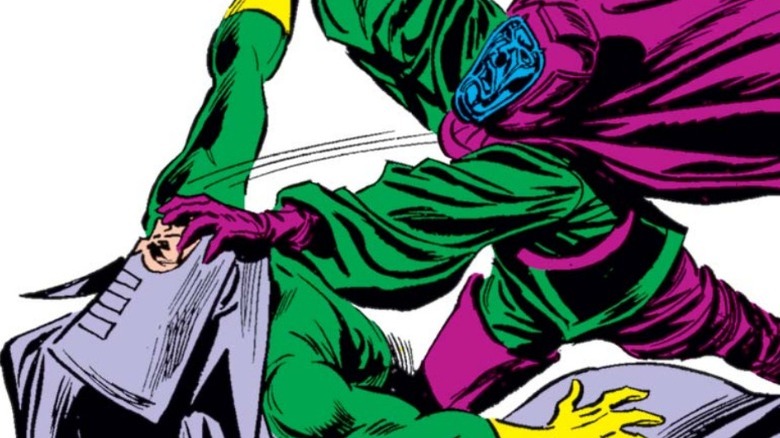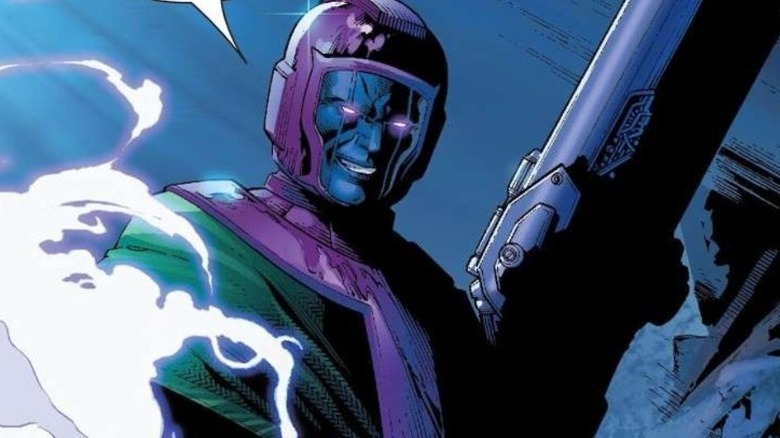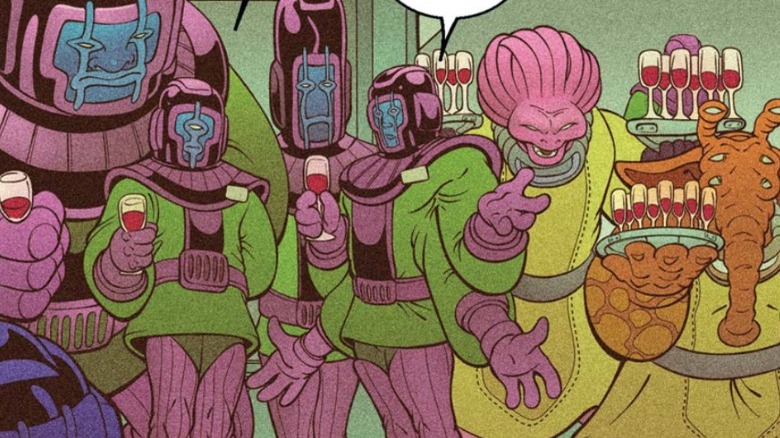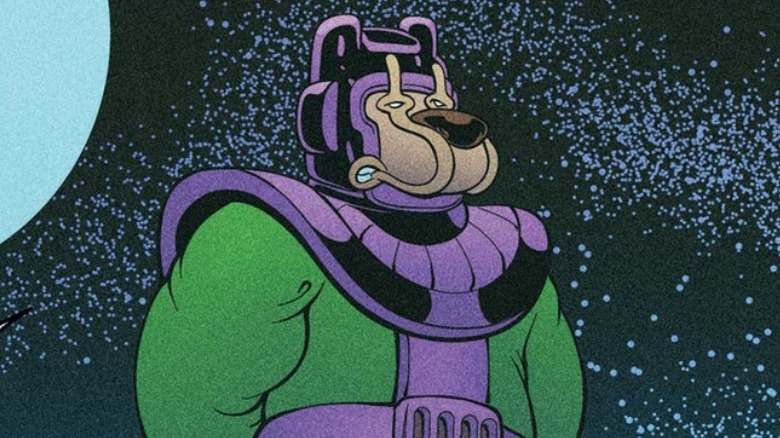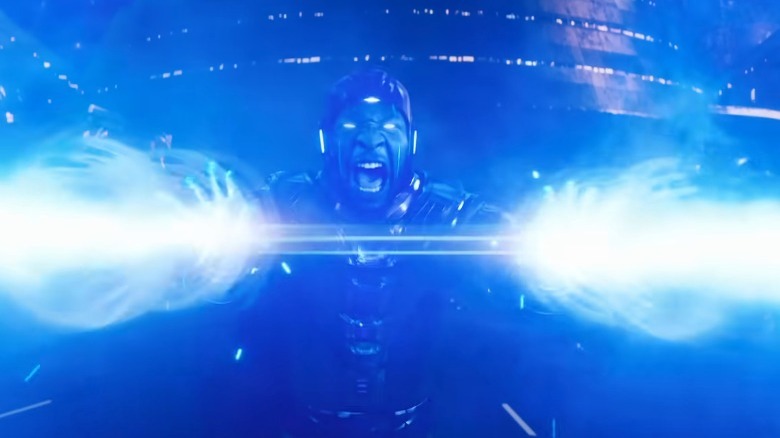Marvel's Council Of Kangs Explained
Contains spoilers for "Ant-Man and the Wasp: Quantumania"
Ever since the ending of "Loki," MCU fans have been dying to learn more about Kang (Jonathan Majors) and his variants. Now "Ant-Man and the Wasp: Quantumania" has arrived, and it finally gave us some deeper insight into Kang.
Fans are already theorizing about how Kang in "Quantumania" is tied to He Who Remains from "Loki," but the two undeniably share a loner status. He Who Remains has been living in Limbo for an unimaginable amount of time, and Kang reveals he's been exiled to the Quantum Realm by a Council of Kangs. The ending of "Quantumania" gives us an up close and personal look at the Council, but it ultimately creates more questions than it answers.
Maybe the Marvel comics can help reveal some answers. Kang the Conqueror formed the Council as part of a secret master plan, but even he didn't realize the Council's true purpose. Before the Council turns its attention to the MCU's Avengers, get the full scoop on how it formed and fell before.
Introducing Kang Prime
Kang dueled with Marvel's heroes back and forth for more than half a century. He first appeared in "Avengers" #8, published in 1964. In that issue, the Conqueror travels to our own time from the distant future, and he comes prepared to take over the entire planet. The Avengers are initially overcome by Kang's superior technology, but by disarming his cybernetic suit they are able to send him back to his own timeline.
In the decades since Kang's first encounter with the Avengers, Marvel's heroes and readers have learned a lot more about this threat from the future. Kang is born sometime in the 30th century, and his real name is Nathaniel Richards. That surname probably sticks out to any True Believers or Fantastic Four superfans. Kang is a very distant relative of Reed Richards, but aside from sharing a sharp intellect, the two don't have much in common.
Kang's birthplace is relatively peaceful, but his hunger for power won't let him rest easy in his own timeline. Because of his constant quest for conquest, countless versions of Kang diverge from his prime timeline, each pursuing their own path to power. The "Prime" Kang may be the first, but he's not the last.
Kang in the multiverse
Kang Prime is from a reality known as Earth-6311, but an infinite number of Kangs exist throughout the multiverse. There might be more versions of Kang than any other character in Marvel comics, and his variants have had huge roles to play throughout Marvel's stories.
Not every Kang is evil or unshakably power-hungry. In one version of reality, a young Nathaniel Richards meets his future Kang self. Kang tells Nathaniel how powerful he will become and gives him access to a suit of armor from the 40th century to speed up his development, but Nathaniel is horrified by what he sees. He becomes the Iron Lad and joins forces with the Young Avengers to try and prevent his future self from becoming so destructive.
More often than not, Kang becomes a villain, but his evil variants adopt different titles and identities. In one reality, Kang travels back to ancient Egypt and comes to rule the land while calling himself Pharaoh Rama-Tut. In another timeline, Kang poses as a hero called the Scarlet Centurion to try and infiltrate the Avengers to take them apart from the inside. Kang is always looking for a new angle and has a single-minded focus whenever he picks a new goal to pursue. But there's one Kang variant who's more powerful, and more evil, than any other.
Becoming Immortus
Almost every version of Nathaniel Richards grows up to become Kang the Conqueror, but that's not the end of his evolution as a villain. In many timelines, Kang becomes the terrifying and unimaginably powerful villain Immortus.
Immortus has everything to do with Limbo and the Time-Keepers. The Avengers get locked into a battle with the Time-Keepers at the end of time, and Kang the Conqueror gets swept up in the fight. In the midst of the battle, Kang's timeline is split, and one version of himself travels to Limbo. There, Kang begins studying Limbo and realizes he has infinite time to do so. After learning how to become a master of time itself, Kang renames himself Immortus.
If Kang's timeline hadn't been split during the Avengers' epic fight with the Time-Keepers, there'd be one less version of the villain to worry about. Instead, Immortus and Kang exist simultaneously, meaning that each one of them has the potential to create more branching timelines and more variants of themselves. Immortus may know everything there is to know about the nature of time, but that doesn't change his thirst for power. To become the most powerful being in all of existence, Immortus has to try and make sure that he's the one true Kang.
Forming the Council
The Council of Kangs first appeared in "Avengers" #267, published in 1986. The Council was part of a three-issue arc that saw Kang using a new strategy to take down the Avengers and become the most powerful person in any timeline.
Kang develops his new plan after accidentally finding his way to Limbo and discovering the skeleton of Immortus. With Immortus out of the way, Kang starts to get curious about other versions of himself that exist in the countless realities of the multiverse. He eventually finds his way to Earth-8657. That reality's Kang is dead, but his lover Ravonna Renslayer is still alive.
With the help of Ravonna, Kang decides that he should continue searching through the multiverse until he can find the strongest versions of himself in existence. Kang thinks that by forming a Council with his variants, he'll be able to become an even more powerful version of himself, but little does he know he's just playing a part in someone else's plan.
The Council's purpose
When the Council of Kangs is introduced in "Avengers" #267, its mission is almost complete. Kang the Conqueror traveled through the multiverse and selected just a handful of his own variants as members of the council. He wanted only the strongest and most bloodthirsty Kangs to join him on his new quest.
As a collective, the Council began murdering every other variant of Kang that they could find. Their goal was essentially to weed out the weakest versions of themselves, and along the way they took whatever bits of knowledge the weaker Kangs had about the nature of time, reality, and warfare. Believing that only other versions of themselves could ever challenge their power, the Council members thought they were making themselves stronger by killing their variants.
In reality, Kang had created the Council as a means to an end. He wants to kill every other version of himself in existence, but he thought the process would go faster if he first recruited other Kangs to help. Once the Council does its job, Kang kills all of them.
Kang betrays himself
The story of the Council of Kangs ends in "Avenger" #269. Just as Kang thinks his master plan is complete, he realizes he's been betrayed. Ravonna Renslayer has secretly been working with Immortus from the very beginning, and the two of them purposefully have manipulated Kang into forming the Council and killing all of his variants.
Kang thinks he was ensuring that he would have ultimate power by becoming the only version of himself still alive, but that's really what Immortus has accomplished for himself. Immortus reveals that he is Kang's future self and that by killing all the variants, Kang has ensured he would always become Immortus. Then Immortus tricks Kang into absorbing all the memories of his dead variants, which nearly breaks his mind. With thousands of lifetimes filling his mind, Kang the Conqueror decides not to fight Immortus and instead escapes into Limbo. Immortus, now satisfied that he's set up Kang to follow in his footsteps, decides to let the Avengers go back to their normal lives while he develops a new plan. That's a wrap on Marvel's comics history of the Council of Kangs, but it's not the last time a group of Nathaniel Richard variants would decide to work together.
Now there's Cross-Time Kangs?
Long after the Council of Kangs has imploded, a new group steps up to the plate. In 1998's "Avengers: Forever" #3 Kang once again finds himself in battle with the Avengers and once again loses. When he flees after the fight, certain would-be supervillains see a new opportunity.
The Council of Cross-Time Kangs temporarily fills the void left by Kang himself. This new Council isn't made up of Kangs at all. Instead, its ranks are filled by ordinary people, though not all of them are humans, who want to claim Kang's power for themselves. By taking advantage of the technology Kang leaves behind after his fight with the Avengers, this group is able to pose as the Conqueror himself for a brief time.
It would have been better if these aspiring dictators would have chosen a different disguise. Kang doesn't take kindly to his impersonators, and in "Avengers: The Terminatrix Objective" #4 he decides to put an end to the Cross-Time Council by sending Alioth, the monster of Limbo, to destroy them so effectively that they're removed from existence. Talk about a harsh punishment.
What about the Kang Collective?
The original Council of Kangs has a very limited membership policy. Only Kangs that are hand-picked by the "Prime" Kang himself are allowed to join, and he only chooses variants who are incredibly strong and willing to travel through time killing alternate versions of themselves. There's another multiversal group of Kangs that isn't so picky about who joins its ranks.
The Kang Collective isn't a group for all-star Kangs but for everyday Kangs. The Collective itself isn't bent on multiversal domination or any particular goal. It's a group where Kangs from across the many realities can gather and commiserate about the difficulties of being themselves. It's a place where Kangs can feel comfortable discussing strategies for world domination or debating if non-human Kangs have an advantage over their primate-evolved counterparts.
The Kang Collective made its first and only appearance — so far — in "Spider-Ham" #4. The group feels right at home in the wacky structure of a Spider-Ham story, but that doesn't mean it's entirely harmless. After all, a group of Kangs that isn't focused on destroying itself could be the biggest threat the multiverse has ever seen.
Marvel's scariest villain or best source of comedy?
Kang the Conqueror is one of the most fearsome villains in all of Marvel Comics. He's able to single-handedly threaten the Avengers, and though the heroes usually come out on top, they've never stopped Kang permanently. When he isn't trying to go toe to toe with Marvel's greatest heroes, Kang is almost effortlessly taking over other timelines and realities. As Immortus, Kang is more or less immortal and in control of the flow of time itself.
That said, there's always room in Marvel for a joke or two. Kang and his variants have definitely been a laughing stock more than once. Remember the Kang Collective from "Spider-Ham"? That group's first appearance ends with members having a meeting about whether or not the Kangaroo variant, which is exactly what it sounds like, should be allowed to stay in the group.
In another universe, Kang becomes a comedic punching bag for Hobie Brown aka Spider-Punk. In "Edge of Spider-Geddon" #1, Kang travels to Spider-Punk's time, intending to capture the hero and transport him back to the future to capitalize on merchandising opportunities. Kang becomes a ridiculous caricature of corporate greed, but at the same time, he puts up such a strong fight that Spider-Punk is barely able to fend him off. Even when he's funny, Kang is still a threat ... but with as many variants as he has, at least one of them has to be a harmless stand-up comedian or something, right?
The MCU's Council of Kangs
Even before the Council of Kangs was introduced "Ant-Man and the Wasp: Quantumania," the MCU was obviously taking Kang the Conqueror in a different direction than the comics. "Loki" Season 1 introduced He Who Remains, a version of Kang that exists in Limbo, protected by Alioth. Those surface details make He Who Remains sound like Immortus, but his personality couldn't be more different than the ultimate evil version of Kang.
"Ant-Man and the Wasp: Quantumania" strays even further from the comics than "Loki." The movie's version of Kang has been trapped in the Quantum Realm for years after being banished by the Council of Kangs. He's miserable, but he should consider himself lucky that the MCU's Council is apparently more merciful than the one that existed in the comics. The film's post-credits scene shows the Council itself, and there are certain Kang variants that seem to come straight from the comics. The Council, though, is entirely different. It seems to have more members than comic book Kang would have allowed, and it doesn't seem all that concerned with killing other Kangs, at least for now.
It's hard to say what the MCU is going to do with Kang or the Council. Clearly the comic book lore isn't being directly adapted, but in all honesty, there isn't much lore about the Council to begin with. Wherever the MCU goes next will be a genuine surprise for every Marvel fan out there.
